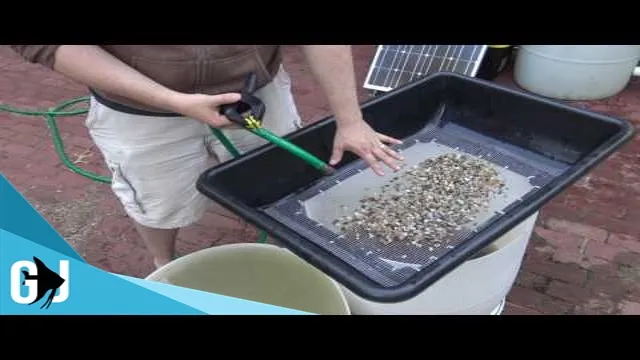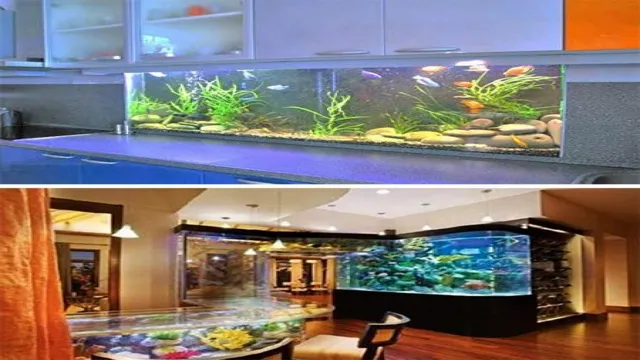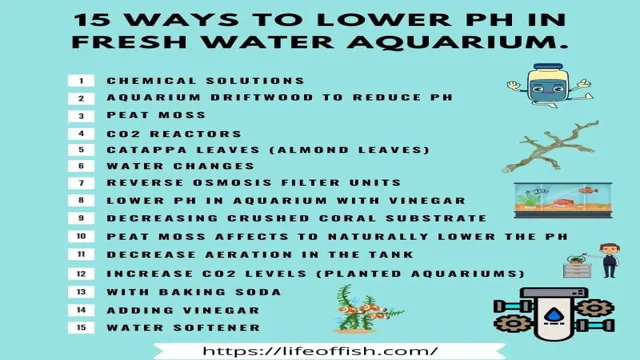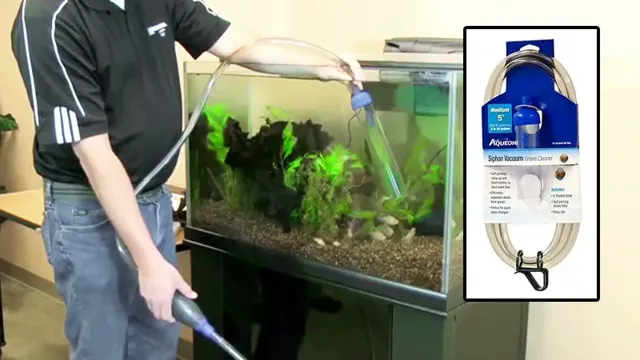Keeping your aquarium clean is an important part of maintaining the health and wellbeing of your fish. One of the most essential tasks in aquarium maintenance is cleaning the gravel. Aquarium gravel cleaning helps remove debris, uneaten food, and waste products to ensure a clean and hygienic water environment for your fish.
However, cleaning the gravel can be overwhelming for new fish keepers. Don’t worry, we are here to help you learn how to do it safely without harming your fish. In this blog, we’ll cover everything you need to know about aquarium gravel cleaning, including tips on how to do it safely and how often you should be cleaning your aquarium gravel.
So, let’s dive in and explore the world of aquarium gravel cleaning together!
Why Do You Need to Clean Aquarium Gravel?
How to clean aquarium gravel safely? Cleaning aquarium gravel is essential to maintaining aquatic life’s health and ensuring that their environment is conducive to their growth and survival. Gravel is a necessary component of the aquarium; it serves as a substrate and provides a surface for good bacteria to grow, which helps break down waste and debris from the fish. Over time, gravel can accumulate dirt, fish waste, and uneaten food, which can break down and pollute the water, leading to ammonia buildup and other harmful conditions.
Cleaning the gravel is necessary to remove these contaminants and keep the water clear. It is essential to know how to clean aquarium gravel safely to avoid harming the aquatic life or damaging the gravel’s live bacteria populations. The gravel can be cleaned using manual siphoning or aquarium gravel vacuum cleaners that can effectively remove dirt without harm.
Ensure to clean the gravel regularly and maintain a healthy environment for your aquatic pets.
Removing Harmful Waste and Debris
Aquarium gravel cleaning is an important aspect of maintaining a healthy and happy aquatic environment for your fish. The gravel in your aquarium can trap a significant amount of debris, waste, and harmful bacteria, which can eventually lead to health problems for your fish. This is why it’s essential to clean your aquarium gravel regularly.
By removing the debris and waste from the gravel, you are ensuring that your fish have a clean and safe habitat to thrive in. Additionally, cleaning the gravel can also help to improve the water quality in your aquarium, which is crucial for the overall health and well-being of your fish. So don’t neglect your aquarium gravel – it’s a vital component of your aquatic ecosystem that needs regular attention.
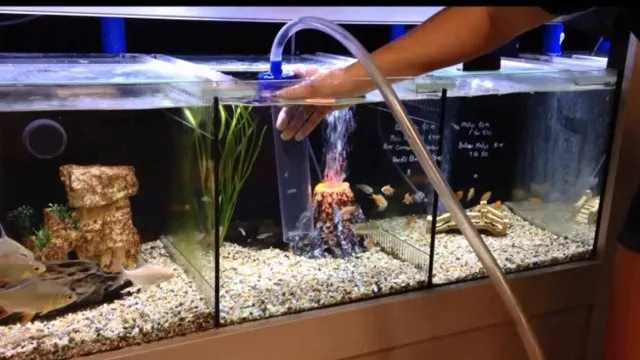
Preventing Algae Growth
Cleaning aquarium gravel is essential for preventing algae growth. Algae can develop quickly in an aquarium, especially if there is an abundance of nutrients, such as uneaten food or fish waste, in the water. These nutrients can accumulate in the gravel at the bottom of the tank, providing the perfect environment for algae to thrive.
Over time, algae growth can spread throughout the tank, making the water cloudy and harmful to fish and other aquatic animals. Cleaning the gravel regularly helps to remove these excess nutrients and prevent algae from taking hold. It also ensures that the water remains clean and healthy for your fish to live in.
So, keep your aquarium gravel free from debris and excess nutrients to keep your tank happy and healthy!
Materials You’ll Need for Safe Aquarium Gravel Cleaning
If you want to maintain a healthy and happy aquarium, it’s essential to clean the gravel regularly. However, many aquarium owners are unaware of the materials they need to perform this task safely. Firstly, you’ll need a gravel vacuum or a siphon to remove any debris that has accumulated in the gravel.
This removes waste and helps control the level of nitrates in the water, keeping your fish healthy. You may also want to invest in a bucket and a hosepipe to transport water, as you’ll need to add fresh water after cleaning the gravel. It’s also helpful to have a clean cloth or a sponge to wipe the sides of the aquarium and remove any algae buildup.
Always remember to switch off any electrical equipment before cleaning and be gentle when handling any live plants or fish. By using these essential tools, you can ensure that your aquarium gravel stays clean and safe for your aquatic pets.
Net or Strainer
When it comes to maintaining a healthy aquarium, cleaning the gravel is essential. However, it’s important to do it safely and without harming your aquatic friends. To start, you’ll need a net or strainer to scoop out any debris or waste that has settled at the bottom of the tank.
Using a net with large holes may accidentally scoop up your fish, so it’s better to opt for a strainer with smaller holes. You’ll also need a siphon hose to suck up any dirt or waste that has made its way into the gravel. It’s important to avoid pressing the siphon too far into the gravel and disturbing your fish’s home.
With these materials and a gentle touch, you’ll be able to safely and effectively clean your aquarium’s gravel for a healthier habitat for your underwater pets. (See Also: How to Build a Rimless Glass Aquarium: Tips and Tricks for a Stunning DIY Aquascape)
Gravel Vacuum
Gravel vacuum When it comes to maintaining the cleanliness of your aquarium, a gravel vacuum is an essential tool. To ensure safe and effective gravel cleaning, you’ll need a few materials. Firstly, make sure to have a bucket nearby to hold the extracted water.
You’ll also need a siphon to create suction and a gravel vacuum attachment to clean the substrate. It’s important to choose the right size attachment for your tank as too small or too large can cause damage to your fish and plants. Additionally, having a pre-filter attached to the siphon will prevent debris from getting sucked into the hose and potentially harming your fish.
Finally, ensure that the water you’re replacing is the same temperature and chemical composition as the water in your tank to avoid shocking your aquatic friends. Remember, regular gravel cleaning with a vacuum can help keep your aquarium healthy and beautiful.
Bucket
When it comes to cleaning your aquarium gravel, you want to make sure you have the right materials on hand to do it safely and effectively. One of the most important tools you’ll need is a bucket. This will make it easy to remove the dirty water from the tank and replace it with clean, fresh water.
When selecting a bucket, you want to make sure it’s made from a safe material that won’t leach harmful chemicals or toxins into the water. Look for a bucket made from food-grade plastic or glass. It’s also a good idea to have a separate bucket designated solely for aquarium use to prevent cross-contamination with other household chemicals or cleaners.
With the right bucket on hand, you’ll be able to quickly and easily clean your aquarium gravel while keeping your aquatic pets happy and healthy.
Water Conditioner
If you own an aquarium, it’s important to keep the gravel clean to maintain a healthy environment for your fish. To do this, you’ll need a few materials: a gravel vacuum, a bucket, water conditioner, and a water-testing kit. The gravel vacuum suctions out the debris from the gravel while leaving the gravel itself undisturbed.
Use the bucket to collect the dirty water as you vacuum, being careful not to suck up any fish or plants. Once you’ve finished cleaning the gravel, it’s important to add water conditioner to the fresh water you’ll be adding back into the aquarium. This ensures that the water is free of any harmful chemicals that can be harmful to your fish.
Using a water-testing kit regularly can tell you if any levels in your aquarium are imbalanced and need adjusting. With these materials handy, you can be sure to keep your aquarium clean and your fish healthy.
Steps for Safe Aquarium Gravel Cleaning
Aquarium gravel cleaning is important for ensuring a healthy environment for your fish to thrive. But when it comes to cleaning it, you must keep in mind the safety of your aquatic pets. If you disturb the substrate too much, it can release harmful gases, leading to health issues for your fish.
First, turn off any filters and heaters and remove any fish and plants. Then, use a siphon to remove excess debris and other waste materials. Be sure not to remove too much water, and neither should you disturb the gravel too much as it can cloud and cause damage to the ecosystem in the aquarium.
Rinse the gravel thoroughly, a few handfuls at a time, in a bucket before placing it back into the tank. Ensure that you use dechlorinated water for rinsing and add a water conditioner if necessary. By following these simple steps, you can help to keep your fish strong and healthy, and their environment sparkling clean!
Step 1: Unplug and Prepare Your Equipment
Aquarium Gravel Cleaning If you’re a fish enthusiast, cleaning your aquarium regularly is essential to maintain a healthy environment for your aquatic pets. Cleaning the gravel is particularly important because it accumulates debris and waste from the fish, which can cause fatal conditions such as ammonia poisoning. However, before you start, it’s crucial to unplug and get your equipment ready.
Turn off the heater, filter, and air pump and remove them from the aquarium. Empty the water into a holding container, but leave about a quarter of it to avoid stressing the fish. Place the aquarium on a sturdy surface with good lighting, as this will help you see the debris and waste better.
Also, prepare a bucket, a siphon, and a net to catch any displaced fish or debris. By unplugging and preparing your equipment, you’ll ensure that you can safely and efficiently clean the aquarium gravel without harming your aquatic animals.
Step 2: Remove Debris with a Net or Strainer
When it comes to keeping your aquarium clean and your fish healthy, regular gravel cleaning is a must. However, before you start vacuuming the gravel, you need to remove any debris that may be floating on the surface. A net or strainer can come in handy here.
Simply skim the surface of the water with the net or run it through the gravel to pick up any debris. This is an important step as leaving debris in the tank can lead to contaminated water, which can put your fish at risk. Remember to handle the debris carefully and dispose of it properly to prevent any further contamination. (See Also: How Thick Glass for 200 Gallon Aquarium: Expert Tips for Optimum Safety and Durability)
Don’t skip this step if you want to maintain a healthy environment for your fish.
Step 3: Use a Gravel Vacuum to Siphon Up Waste
Now that you have removed the debris and excess fish food from your tank, it’s time to use a gravel vacuum to siphon up the waste that has settled on the bottom of the tank. A gravel vacuum works by drawing water out of the tank, along with any debris that it comes into contact with. To use a gravel vacuum, you will first need to attach it to a hose and submerge the end of the hose in the tank.
Then, turn on the vacuum, and begin moving it over the gravel, removing any waste that you come across. Be sure to regularly check the water level in your tank, and stop using the vacuum once you have removed 25% of the water. Using a gravel vacuum is a crucial step in maintaining a clean and healthy aquarium, and it will help to prevent the build-up of harmful toxins that can harm your fish.
Step 4: Refill with Water and Add Water Conditioner
Aquarium gravel cleaning Once you’ve removed the dirty substrate, it’s time to refill the tank with fresh water. Before doing so, add a water conditioner to the water to remove any harmful chemicals or toxins. This will ensure that the water is safe for your fish and won’t harm them.
Make sure to follow the instructions on the water conditioner bottle carefully to avoid over-treating the water. Once the conditioner is added to the water, slowly refill the tank. Be careful not to pour the water in too quickly or too forcefully as this can disrupt the gravel bed and harm your aquatic plants or fish.
A good rule of thumb is to replace no more than 25% of the water at a time to avoid shock to the ecosystem. Once the tank is filled, turn on the filter and let it run for a few hours to ensure that the water is fully circulated and oxygenated. By following these steps, you’ll have effectively cleaned your aquarium gravel, refreshed your tank, and provided a safe environment for your aquatic pets to thrive.
Tips for Safe Aquarium Gravel Cleaning
If you want to keep your aquarium clean and healthy, then it’s important to know how to clean aquarium gravel safely. Gravel is an important element in an aquarium as it not only provides a natural look, but it also serves as a filter for the water by allowing beneficial bacteria to grow. However, over time, gravel can accumulate waste that can degrade the water quality, making it necessary to clean it from time to time.
To clean the gravel, you can use a vacuum siphon that will remove the debris without disturbing the gravel. You should avoid using soap or any other cleaning agents as they can harm your fish. It’s recommended to clean the gravel once a month and to replace a portion of it every six months to remove any accumulated toxins.
By following these tips, you will ensure that your aquarium is a healthy and thriving environment for your fish to live in.
Avoid Overcleaning
Aquarium Gravel Cleaning When it comes to cleaning the aquarium gravel, it’s important not to overdo it. In fact, overcleaning can do more harm than good to your fish’s habitat. While you want to keep the water clean and clear, you also want to maintain a healthy balance of good bacteria that settles on the gravel.
Ideally, you should aim to clean about 20-25% of the gravel every 2-3 weeks, depending on the size of your aquarium. When cleaning, it’s best to use a siphon vacuum to remove the excess debris without disrupting the gravel too much. Be gentle and avoid scraping the gravel as this can upset the bacteria balance and release toxins in the water.
Remember, a little bit of dirt in the gravel is normal and healthy for your aquarium’s ecosystem.
Don’t Clean All at Once
When it comes to aquarium gravel cleaning, it’s crucial to take it slow and not clean all at once. Getting rid of all the debris and dirt can be tempting, but doing so can disrupt the delicate balance of the aquarium’s ecosystem. It’s essential to keep in mind that beneficial bacteria thrive in the substrate, and when we remove them, we risk harming the fish and the plants.
Therefore, we need to be thorough but careful in our approach. The best way to do it is by dividing the cleaning process into sections and doing it over several days. Also, don’t forget to use a gravel vacuum that allows you to get rid of the debris while keeping the gravel intact.
With this approach, you’ll have a clean and healthy aquarium, and the inhabitants will thank you.
Add Beneficial Bacteria After Cleaning
When it comes to cleaning aquarium gravel, it is important to keep in mind the safety of your aquatic pets. One important tip to remember is to add beneficial bacteria after cleaning. This is because gravel cleaning can disrupt the natural balance of bacteria in the tank. (See Also: How to Diversify Genetics in Breeding Aquarium Fish: Tips and Techniques)
Beneficial bacteria play a crucial role in breaking down waste and preventing the accumulation of harmful compounds like ammonia and nitrate. By adding beneficial bacteria after cleaning, you can maintain a healthy and balanced ecosystem for your fish and other aquatic organisms. Make sure to use a high-quality bacteria supplement and follow the instructions carefully.
With just a little bit of extra care, you can keep your aquarium sparkling clean and your aquatic pets happy and healthy!
Regular Maintenance Is Key
Regular maintenance is the key to ensuring your aquarium stays healthy and safe for your fish. One important aspect of aquarium maintenance is cleaning the gravel at the bottom of the tank. Not only does this keep the tank looking clean, but it also removes any built-up waste and debris that can harm your fish.
When cleaning the gravel, there are a few tips to keep in mind to ensure it is done safely. First, make sure you turn off any filters or pumps that can stir up debris. Second, use a gravel siphon to remove debris without removing too much water, which can upset the balance of your aquarium.
Finally, avoid cleaning the entire tank at once as it can shock your fish – instead, focus on one small area at a time. By following these tips, you can clean your aquarium’s gravel safely and efficiently, keeping your fish happy and healthy.
Conclusion
So there you have it, folks! Cleaning your aquarium gravel may seem daunting at first, but with the right tools and a little know-how, it can be done safely and efficiently. By following these simple steps, you can keep your aquatic ecosystem healthy and thriving for years to come. So don’t be afraid to dive in and get your hands dirty – your fish (and their grateful fins) will thank you for it!”
FAQs
Can I clean aquarium gravel with soap or detergent?
No, using soap or detergent can harm your fish and plants. It is recommended to use a gravel vacuum and water changes to clean the aquarium gravel safely.
How often should I clean aquarium gravel?
It is recommended to clean aquarium gravel once a month to maintain a healthy environment for your fish and plants.
Do I need to remove my fish from the tank when cleaning aquarium gravel?
It is not necessary to remove your fish from the tank, but it can make the cleaning process easier and less stressful for them.
How do I use a gravel vacuum to clean aquarium gravel?
Place the vacuum in the tank and let the gravel get sucked up into the vacuum. Move the vacuum around to clean all areas of the gravel, then dispose of the dirty water.
Can I reuse the water I removed during cleaning the aquarium gravel?
No, it is not recommended to reuse the water because it can contain harmful waste and debris. It is better to use fresh water and add dechlorinator before adding it to the tank.
Can I clean aquarium gravel without a gravel vacuum?
Yes, you can use a net or a scoop to remove debris and waste manually. However, using a gravel vacuum is more effective and efficient.
How can I prevent harmful bacteria from growing in the aquarium gravel?
Regular cleaning and maintenance can prevent harmful bacteria from growing in the aquarium gravel. It is also important to avoid overfeeding your fish and to remove any uneaten food promptly.

